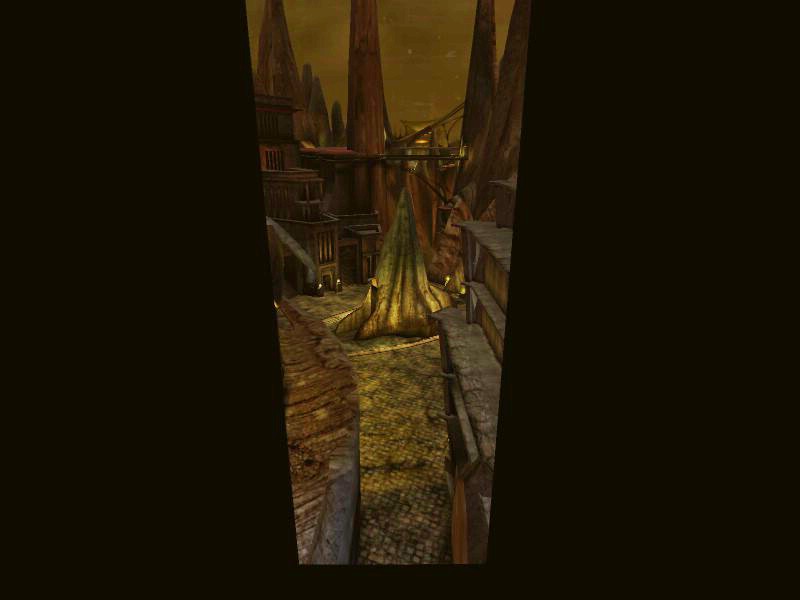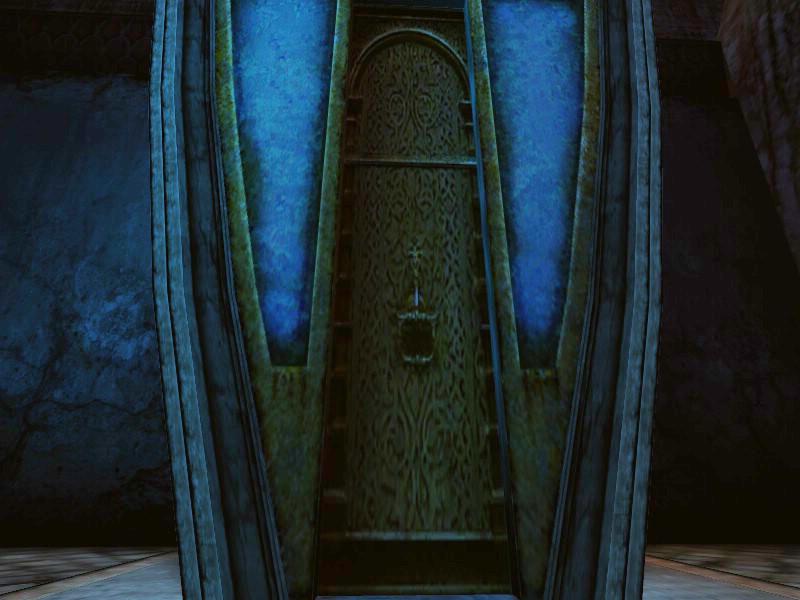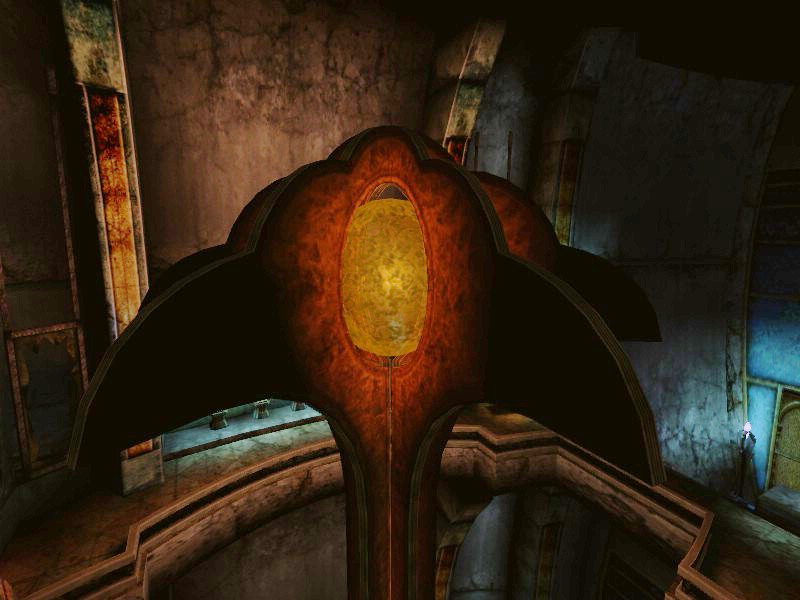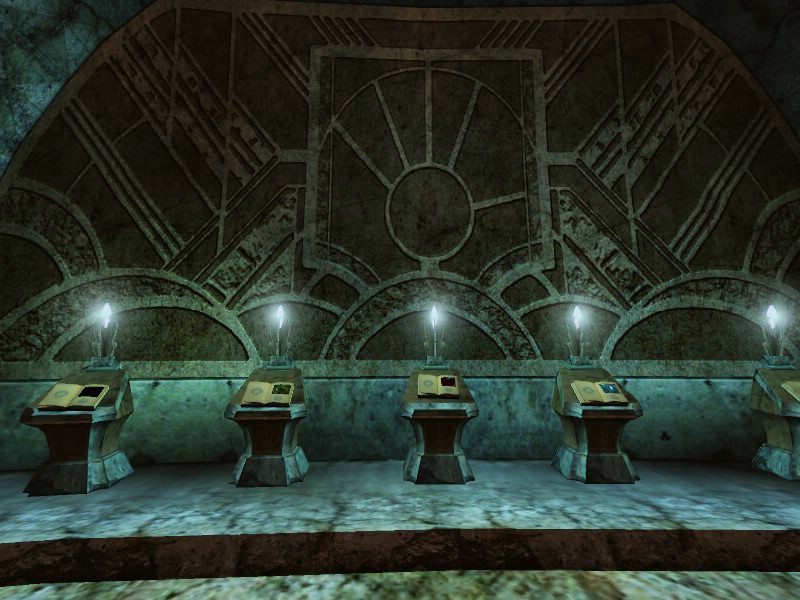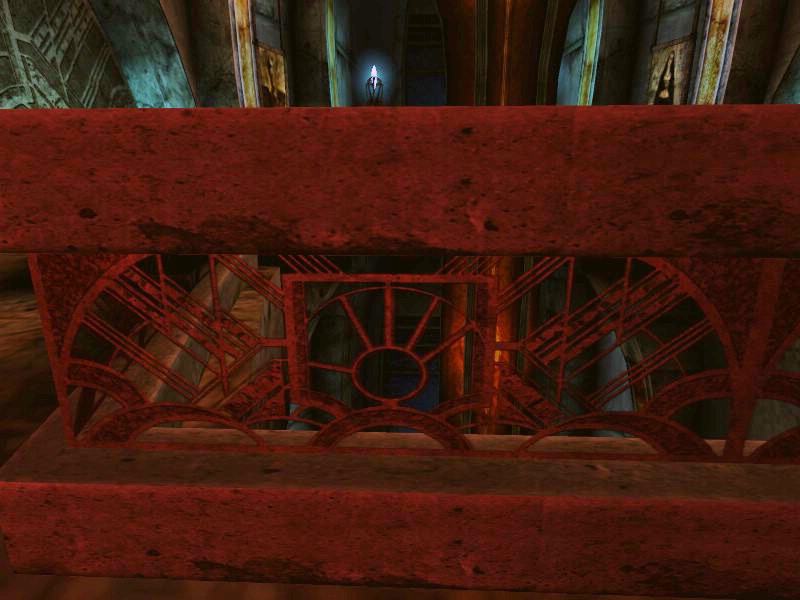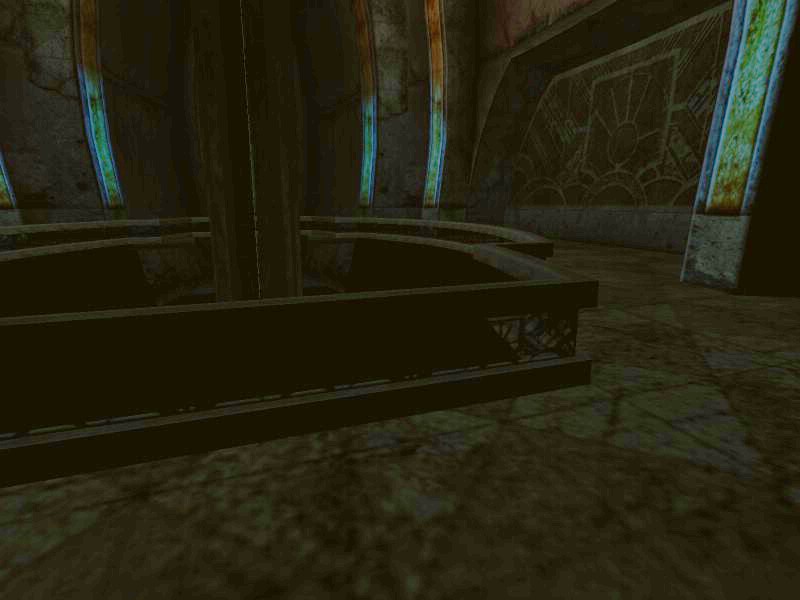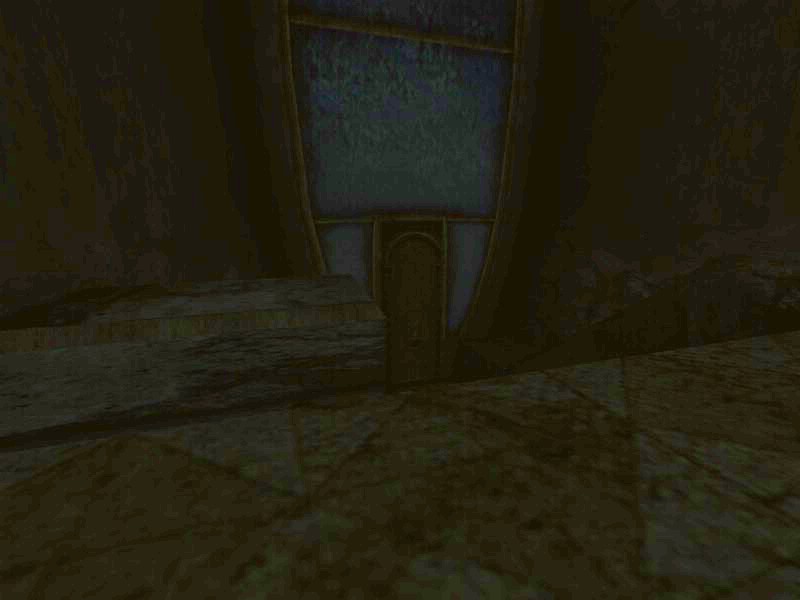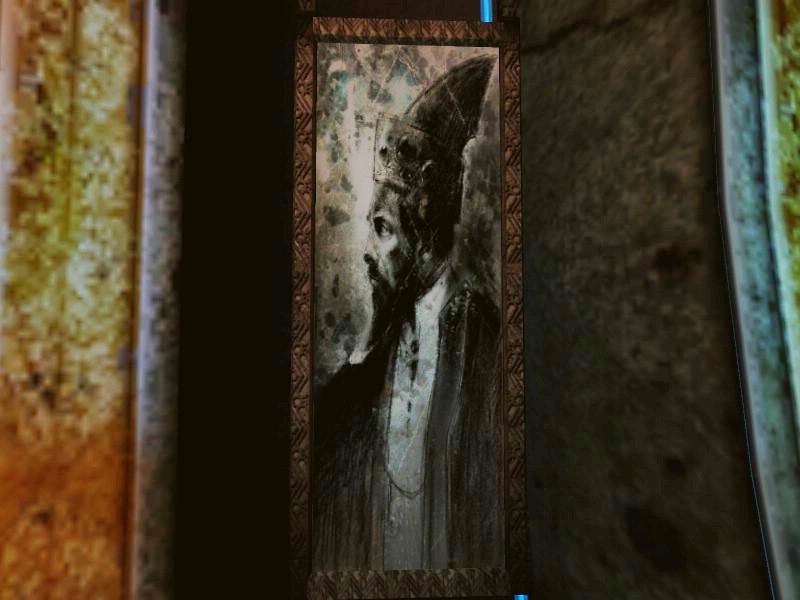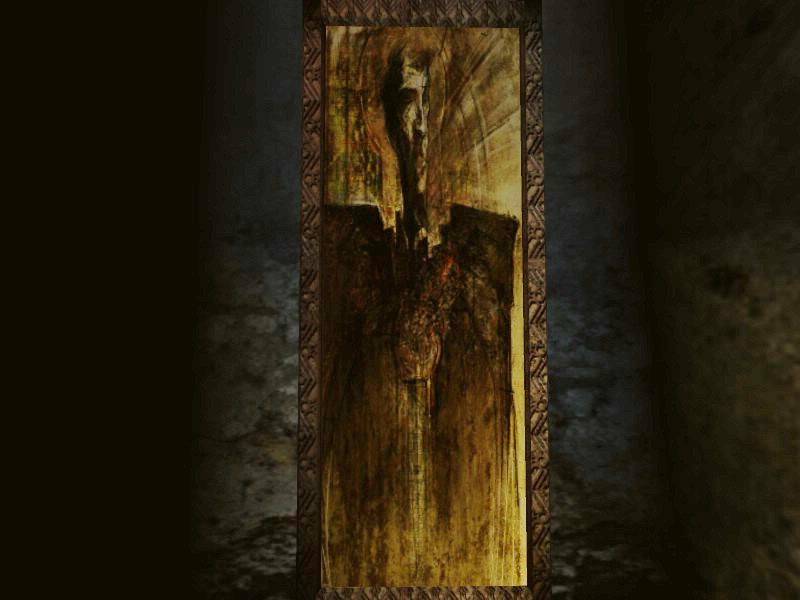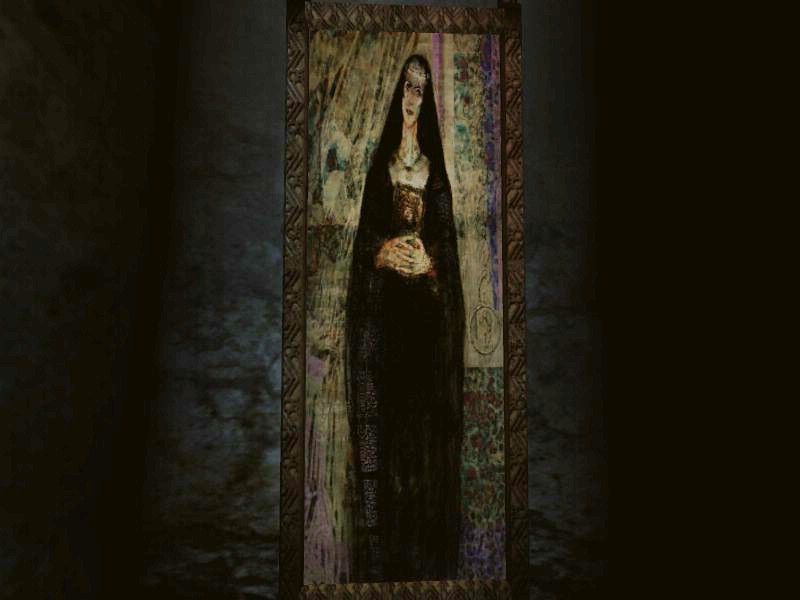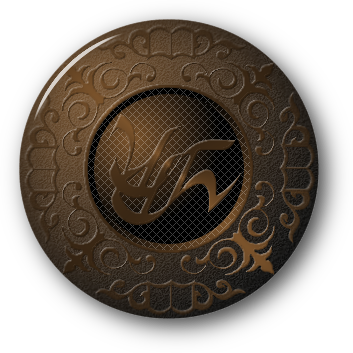

|
|
The museum was the D'ni name for this building. It comes from a pamphlet that was found and which is in DRC possession. Despite the name, the museum had few exhibits that were actually in the building; instead, it was a common library for linking books to observation pods, all on the same world. Of the books it hosted, only four Reziksehv pod books remain out of at least twenty-five.
The Museum is a building with a rooftop similar to that of Tokotah II superstructure #1.Inside, there are two floors, the lower of which is inaccessible to explorers. There are wall and railing decorations that are the same rayed hand designs as those found in the Great Library, which may indicate that both buildings served much the same purpose, holding public linking books with a common theme.
This is the Museum's main entrance door. Currently, it's broken and does not close. When it works, it drops straight down into a slot below it, moving vertically.
Along the walls surrounding a central opening that contains a lamp sculpture are ten linking book pedestals, five on each side. On the right hand side as you enter the building, four of the pedestals hold linking books to observation pods on a world that has been called Reziksehv, although this just means "the pod Age" in D’ni. The Age holds at least twenty-five pods, since that number is marked on the map and Dereno has a number plate bearing the number 25. It has been theorized that Reziksehv is the ringed planet around which a moon called Todelmer orbits. If true, then there is a twenty-sixth pod in orbit in the ring system. The orbital pod’s linking book may sometimes be found on the center pedestal if certain conditions are met, but those conditions cannot be filled by most explorers. Under normal circumstances that spot holds a Relto page which adds a sun and two moons to Relto. On Todelmer, there is a Bahro pedestal that allows one to reach the orbital observation pod if the right symbol is inscribed on it.This is the central lamp.
Pedestals and wall design. You'll see all five Pod books in the picture below, but note that the middle book was added for the purposes of this photo. You'll probably never see it. That spot is normally occupied by a Relto page. If both floors of the museum were originally laid out like this, then there would have been twenty books on display at any given time. The DRC found a pamphlet that would have been handed out for the Negilahn pod, and here is a translation of it.
View of the design on the railings:
The lower floor of the Museum is almost the same as the upper floor, except that it does not have an exit on the building entrance side, since the stairs from the entrance to the upper level are there. It does have a door at the opposite end, identical to the door at the south end of the upper level. I presume that there is a staircase on the other side of the door linking the levels.The lower level. This level has no linking book stands:
Exit door on the lower level:
The paintings: There were once four paintings on the walls of the upper level. Three of them remain. They are: King Kerath: Kerath was the last king of D’ni. After ascending to the throne, he made many changes which eventually culminated in the creation of a city council system that was composed of civic leaders and members of the D'ni guilds. He turned over rule of D'ni to the council and voluntarily abdicated his throne in 6977 DE (679 BCE). Kerath was considered the most important king in D’ni history, and the Arch of Kings was renamed the Arch of Kerath to honor him.
King Ahlsendar: Ahlsendar was the man who was called the Great King, since he seemed to fit the D’ni prophecy that a "great king" would come to Ae’gura on a boat under the Arch of Kings. It was said that when his mother fled the Pento invasion sparked the the Judges sect, he was born as she passed under the Arch while escaping. He later returned to confront the Pento, and passed under the Arch a second time. This seemed to fulfill the prophecy, so people began to call him the Great King. On Ahlsendar’s orders, the D’ni healers created a plague that was intended to be used against Pento. However, while Pento was devastated as planned, the plague turned out to be too virulent and it spread to other Ages and began to wipe out the D’ni as well. Ahlsendar announced his involvement in the creation of the plague, and gathered all of the books linking to the infected Ages. He then locked himself and the books in the Temple of the Great King, leaving the throne of D'ni to Solath. Six months later, Solath was officially crowned king. The Temple of the Great King was later renamed the Tomb of the Great King to honor Ahlsendar’s self-sacrifice. However, this move proved to be controversial and much later strife was born because of it.
Queen Lalen: Lalen was the wife of King Hemelin and was instrumental in finally ending the Pento Plague. She met Hemelin when he fell ill from the plague and she was assigned as his nurse to take care of him. He would later credit their blossoming love for his survival. Two years later in 2257 DE (5400 BCE), Lalen’s research lead to the location of lost Ages of the Healers’ Guild. This, in turn, led to the discovery of the Book of Birenni, which held a cure for the plague. The Guild of Healers declared the plague eradicated on the same day Hemelin and Lalen were married.
|
Myst, the Myst logo, and all games and books in the Myst series are registered trademarks and copyrights of Cyan Worlds, Inc. Myst Online: Uru Live is the sole property of Cyan Worlds Inc. The concepts, settings, characters, art, and situations of the Myst series of games and books are copyright Cyan Worlds, Inc. with all rights reserved. I make no claims to any such rights or to the intellectual properties of Cyan Worlds; nor do I intend to profit financially from their work. This web site is a fan work, and is meant solely for the amusement of myself and other fans of the Myst series of games and books. |

